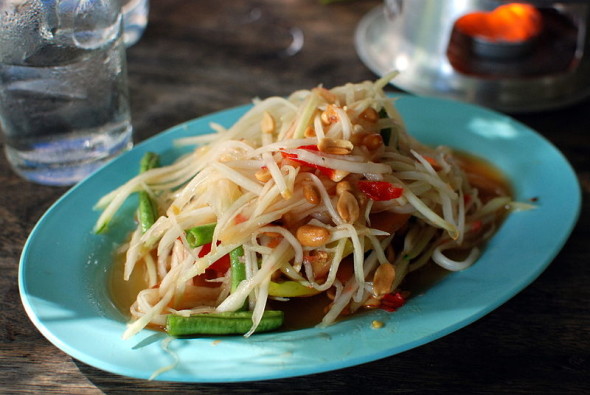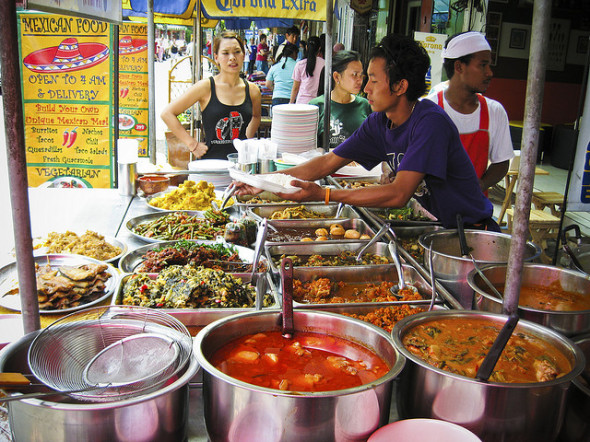I had lunch with a Thai friend at a Bangkok food court a couple of days ago. At some point during the meal, she asked me if I used to eat Thai food when I lived in America and, if so, what the difference was between Thai food in Thailand and Thai food in America. After thinking for just a couple of minutes, I narrowed it down to five quick things — all of which make Thai food in Thailand the preferable choice.
1. Price – Of course, many ethnic cuisines eaten in America are more expensive than the same food in their home country. The difference between Thai food in America and Thai dishes in Thailand, however, when it comes to price, is absolutely astronomical. A typical Thai dish that I can buy at thousands of street stalls and small restaurants all over Bangkok costs around 35-40 baht ($1.12 to $1.29) and that’s plenty of food for lunch.
In a Thai restaurant in the US, the same dish (well, it looks the same but doesn’t taste the same) is $10 or 300 baht — almost 10 times more expensive.
2. Less Spice – Before I moved to Thailand, I used to eat at a Thai restaurant in the US at least twice a week as Thai food was my favorite cuisine. The last time I was in the US, my parents took me to a Thai restaurant for lunch and I ordered stereotypical dishes I would normally eat in Bangkok. Not only did the “spicy” dishes hardly have any spice at all, but the taste itself without the Thai herbs and spices chocked full of flavor was really quite bland.
Of course, Thai dishes in the US in most Thai restaurants are made for American taste. After a decade in Thailand, unless I add a ton of chili peppers, I can no longer eat them.
3. Where’s the Rice? – In Thailand, unless you eat noodles, a typical Thai meal includes a large portion of white rice, a lot of vegetables and a small portion of meat, chicken or fish. In America at a Thai restaurant, unless it’s in the middle of an American Thai town and serves mainly Thais, you get a small portion of rice, a few vegetables and a huge portion of meat. Americans like to eat a lot of meat. Thais don’t, as it’s not very healthy.
So,when you come to Thailand, don’t be disappointed if the Khao Moo Deng (red pork with rice) has a tiny amount of pork and a whole lot of rice. It is healthier for you, though.
4. Too Much Sugar – Thais add sugar to everything — noodles, rice dishes, soups, drinks, desserts — you name it, it has sugar in it. When American Thai restaurants add sugar to their dishes, though, they cater to the American taste. That means too much sugar in everything so, again, the true Thai taste just disappears.

5. Dried Shrimp Does a Runner – In Thailand, dried shrimp is in half the dishes Thais make. It’s a little strong tasting to get used to but, once you do, Thai food would never taste the same without it. In many Thai restaurants in Thailand, however, the dried shrimp is omitted. Maybe because they think Americans won’t be able to handle the strong fishy taste?
All I know is if Pad Thai (rice noodles with peanuts, egg and bean curd and, yes, dried shrimp) or Som Tam (spicy green papaya salad) doesn’t have dried shrimp as one of it’s ingredients, it’s not Pad Thai or Som Tam at all.
If you come to Thailand expecting to eat the same tasting Thai food you eat in America, be warned, you will be sorely disappointed. If you give it a chance, though, and eat it the true Thai way after just a few days you’ll be wondering how you ever ate anything else.

